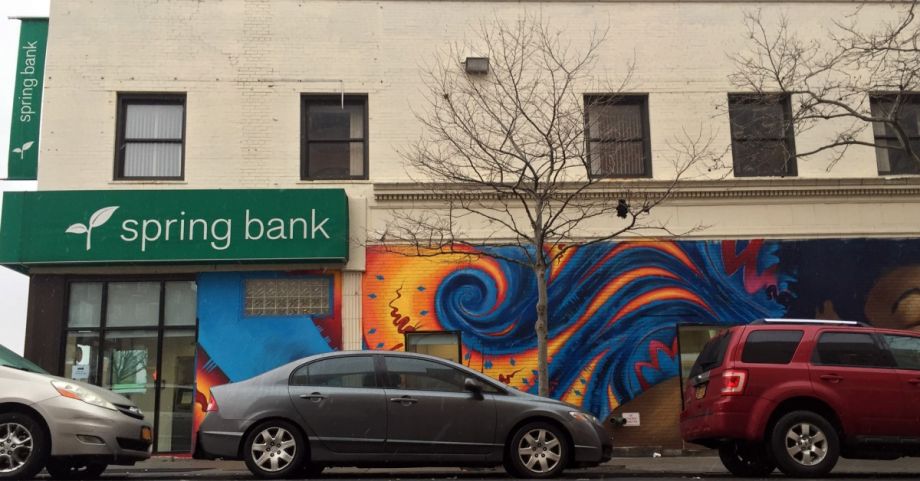On East 167th Street in the Bronx, there’s a commercial corridor anchored by stops on two subway lines. Along the stretch are fresh fruit and vegetable markets, nail salons and barbershops, eye care and dental offices, hardware stores, a furniture store, bodegas, check cashers, pawnshops, and the main branch and headquarters of Spring Bank — one of only two active banks headquartered in the Bronx.
One thing you won’t find on this stretch of East 167th Street in the Bronx is any obvious indication you’re actually in the poorest congressional district in the country, with a median income of just $28,047. It should come as no surprise that it is also the congressional district with the highest percentage of residents of color. Banks tend to ignore communities like these; 17 percent of black households and 14 percent of Hispanic households are unbanked, compared with just three percent of white households.
“The more you [run a community bank in the Bronx] the more you see the lack of inclusion is baked into stuff,” says Demetris Giannoulias, the Chicago-born co-founder and CEO of Spring Bank.
Reports submitted to federal regulators show Spring Bank’s borrowers, both individuals and businesses, are disproportionately located in low-to-moderate income census tracts. All of its small business lending in 2016 and 2017 went to businesses with less than $1 million in revenue. Yet it is financially sustainable — if it wasn’t, like any bank it would get in trouble with regulators.
There are many reasons, including systemic racism, that explain why community banks don’t emerge more frequently in places like the Bronx or Harlem, where Spring Bank opened its only other branch in 2012. The bank’s origin story sheds some light on the challenges facing anyone who might be interested in starting one, especially since the COVID-19 pandemic has revealed some of the shortcomings in the current state of the banking industry. For one thing, a pandemic-induced recession doesn’t have to discourage anyone from starting a bank; Spring Bank opened its doors in late 2007, and the next year a financial crisis tanked the global economy.
“Lucky for us we hadn’t put very many loans on the books before it all blew up,” Giannoulias says.
The role of privilege in the form of family wealth and previous industry experience played a role in Spring Bank’s origin. In some ways, the bank’s origin story is very typical of community banks. A group of banking industry veterans came together, found a viable location, crafted a business plan, sought the needed regulatory approvals and raised the minimum required startup capital from their own pockets.
“The pattern of de novo community banks was almost always the same,” says banking industry veteran George Surgeon, now a Chicago-based banking consultant. “It would be a group of guys, and it was almost always guys, who had worked in one of the big banks or had worked in a large community bank that got acquired, and they would take those big checks from the acquisition deal and use it to start a new bank.”
Banking is a family business for the Chicago-born Giannoulias. His Greek immigrant father, Alexis, founded Broadway Bank in 1979, serving the far north side of Chicago. Demetris eventually rose to be CEO of Broadway Bank, and would remain so until 2010, when it closed during the Great Recession wave of bank closures.
It was a client of Giannoulias who introduced him to a group of banking industry veterans in New York City, who by 2007 had already spent several years trying to charter a new bank in the Bronx. Hitting it off with the group, Giannoulias signed on as a founding board member and the largest investor, ploughing a piece of his family wealth into the new bank.
He’d been to the Bronx before, but not to East 167th Street.
“I remember coming to 167th Street the first time, walking around, noticing all the check cashers and money transmitters on the street,” Giannoulias says.
Spring Bank’s initial business plan was to compete directly with check cashers, offering similarly priced services in a setting that would feel similar to a check cashing storefront with transparently labeled prices for a similar range of services. Initially, the institution didn’t even have the word “bank” in the name, instead it was called CheckSpring. The idea was for the bank to gain customers’ trust and introduce them to more mainstream banking services over time, generating more revenue for the bank. Giannoulias says he also encouraged the founding team to add more commercial and small business lending as revenue-generators for the bank’s initial business plan.
A business plan for a new bank, called a “de novo” bank in banking lingo, has to convince at least two regulators — the FDIC, which provides deposit insurance, and a chartering agency. In the U.S., banks can apply for a charter from the state in which they’re located or the Office of the Comptroller of the Currency. A bank charter is a license to hold deposits as well as a license to create money — through the process of making loans, private banks actually create the majority of money in the modern economy.
A license to create money is not to be taken lightly, which is why, in addition to the business plan, regulators also deeply scrutinize the potential board members and management team outlined on a de novo bank application. Previous experience in banking counts for a lot in the eyes of regulators.
With their business plan and combined previous experience in banking, the founders of Spring Bank eventually obtained a charter from New York State’s Department of Financial Services and approval for federal deposit insurance by fall 2007.
Raising startup capital for a bank is hard to come by if you’re not already wealthy, and even harder if your plan isn’t to make a ton of money for investors. Spring Bank’s founders raised $16 million in startup capital, with the majority coming from the Giannoulias family. Giannoulias eventually came to be CEO of Spring Bank after the Great Recession claimed his family’s bank in Chicago.
Spring Bank was one of 164 new banks that opened for business in 2007 — not an unusually high or low number of new banks per year before the 2008-2009 financial crisis. But new bank formation slowed down dramatically after the crisis, due to uncertainty and also regulatory changes that increased the amount of startup capital necessary for a new bank. From 2010-2018, just 26 new banks opened for business across the country, including zero new banks in 2012, 2014, and 2016.
Even before 2008, it was very rare for new community banks to have an explicit focus on historically marginalized communities. Surgeon says most new community banks got their start by poaching customers from the big banks that bought up previous community banks — often the customers that had relationships with the same banking executives before they sold off the previous community bank.
Spring Bank did not start out in the typical way. Giannoulias says early on, the bank would routinely encourage check-cashing customers to apply for “plain vanilla” credit cards, using a third-party company to process applications. But everyone kept getting rejected. They had to stop offering the product.
“It was making us look bad,” Giannoulias says. “So we looked into why, and you get to this idea that it means the product is not inclusive. Serving this community goes a little deeper than just opening up a location here, you have to create products that meet their needs.”
The bank re-tooled, bringing in some additional staff with deep experience serving underserved borrowers, eventually leading to new consumer lending products that don’t rely on credit scores or collateral.
On the business side, they created a program designed like a ladder for underserved small business owners. It starts with a minimal amount of paperwork for a small bit of credit and increases the paperwork on file as well as their access to credit as they grow their businesses. The bank has also come to rely on referral relationships with local agencies and public officials, whose offices regularly field requests for assistance from constituents looking for access to credit to start or grow small businesses.
A few times a year, Giannoulias says, Spring Bank works with smaller credit unions in other parts of the city to purchase small business loan participations, supporting greater access to credit than those institutions can provide by themselves to small businesses in historically disinvested communities.
The bank has also gotten direct financial support from the public sector. Early on, it obtained federal certification as a community development financial institution, or CDFI, meaning at least 60 percent of its lending and other services must be targeted to low or moderate income borrowers or communities. CDFI certification makes the bank eligible for financial assistance from the U.S. Treasury’s CDFI Fund, which it has used to supplement its earnings in order to meet regulatory requirements to keep a certain amount of capital in reserve for every dollar the bank grows.
The bank’s chosen location and chosen market of underserved communities has probably, at least at this point, changed the bank more than the bank has changed the community.
In July 2019, the bank re-incorporated as a benefit corporation, meaning that its dual mission to serve underserved communities while producing some financial returns to investors is now enshrined in its legal status, not just press releases. Giannoulias says he has never received an offer to buy the bank, but if it ever happened the legal status status means the bank’s non-financial goals are harder to wipe away than simply buying out the founders.
Spring Bank was also the first bank in New York City to become a Certified B Corporation, meaning it meets a certain threshold of impact on an annual basis as determined by the nonprofit B Lab. The annual reporting to B Lab is part of the bank’s legal obligations as a benefit corporation.
As far as it has come, it’s no secret that Spring Bank benefited from the wealth and privilege of its founders, which would be difficult if not impossible for the average person from the poorest congressional district in the country to amass.
“At the beginning, we were basically just trying to get a management team that passes regulatory muster,” Giannoulias says. “Our management team is not necessarily representative of the community that we serve. It’s something we have to work on.”
The bank’s leadership stability has been a blessing and a curse. Giannoulias says there just hasn’t been an opportunity to fill a vacancy on the bank’s executive suite, although its mid-level and lower-level staff are much more reflective of the Bronx — and he largely credits them for the bank’s ability to connect with borrowers in its target markets. Without those borrowers, the bank couldn’t survive as long as it has, especially through the Great Recession.
Giannoulias also points out the lack of senior openings is partly a function of the bank’s business strategy — if it was out to grow faster for the sake of profit, it might have more senior positions for more diverse people to fill. Competition is also fierce for qualified staff who look like the communities Spring Bank serves — last year the bank’s director of small business lending, a Latina, left for a position with a national community development loan fund.
At the Community Development Bankers Association, chief executive and senior policy advisor Jeannine Jacokes notes that each of the trade group’s 82 members, including Spring Bank, has its own unique origin story. Jacokes says before the financial crisis, it was more common for potential new bank founders to approach the association for advice on how to deal with regulators or help finding board members or crafting a business plan. The hardest part, she says, is always raising the minimum required startup capital.
For some Community Development Bankers Association member banks it was family wealth; in some cases communities that won settlements for lawsuits accusing banks of discrimination used the settlement money to start up a bank; the state of Virginia and the federal government have provided the seed capital for some members of the Community Development Bankers Association. In other cases one or more philanthropic donors have come together to provide the initial seed capital to start a bank.
“With foundations, they’ve got their IRS rules, they have to give away 5 percent of their earnings every year to tax-exempt institutions,” says Jacokes. “Banks are kind of a square peg in that round hole, but foundations don’t have to do only what the IRS says they have to do as a minimum.”
It’s frustrating, but also encouraging, that there is no cookie-cutter way to start a bank with a focus on underserved communities — others who wish to do so don’t need to feel like they have to follow a specific model or plan to do it.
Starting a bank is no easy task, but consider the odds that Spring Bank overcame. The poorest congressional district in the country as a home base, an overwhelmingly non-white target market in an economy stacked against non-white workers and business owners, a neighborhood chock full of check cashers and pawnshops to compete with, and a regulatory landscape that favors large banks over small banks. A massive financial crisis that hit nearly as soon as it opened for business, leading to a global recession.
Spring Bank has made it through all of that so far.
“This idea that a for-profit institution can be a force for good, while I think there’s been a lot of movement around that concept, I still think the vast majority of people have a hard time connecting the dots that a for-profit institution can be a force for good if that’s what they set their minds to do,” Jacokes says.
Editor’s note: We’ve corrected the spelling of Demetris Giannoulias’s name.
This article is part of The Bottom Line, a series exploring scalable solutions for problems related to affordability, inclusive economic growth and access to capital. Click here to subscribe to our Bottom Line newsletter.

Oscar is Next City's senior economic justice correspondent. He previously served as Next City’s editor from 2018-2019, and was a Next City Equitable Cities Fellow from 2015-2016. Since 2011, Oscar has covered community development finance, community banking, impact investing, economic development, housing and more for media outlets such as Shelterforce, B Magazine, Impact Alpha and Fast Company.
Follow Oscar .(JavaScript must be enabled to view this email address)


















